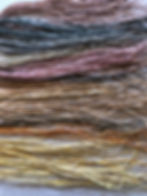Can I Dye Raffia to Weave a Raffia Basket ? A guide to adding colour.
- Ruth Woods
- Oct 13, 2023
- 4 min read
Updated: Mar 23, 2024
Raffia Baskets dyed with plant dyes

Can I dye raffia? This is a question I get asked a lot!
In this blog post I will talk about dyeing raffia - there are many elements to this process and If you’d like to see the whole workshop you can enrol in my online workshop Natural Dyeing Techniques for Raffia and Fabric. With over two hours of lessons teaching you about this process there is a lot to learn.
I’m giving a 30% discount for this workshop.
CODE: RAFFIABLOG30

What is Raffia?
Raffia, a natural fibre obtained from the raffia palm (Raphia spp.) native to Madagascar, it is a versatile material widely used in crafts, including basket weaving, hat making, and various decorative projects. While raffia is commonly known for its natural beige colour, many people wonder if it is possible to dye this fibre to create various craft projects including baskets.

Dyeing Raffia with Plants
If you like an eco-friendly approach or desire unique and subtle hues, natural dyes offer an excellent way for dyeing raffia.
Below are three plant fibres that can be used, of course there are many more. The plants that contain tannins don’t need to be mordanted ( this is a process that helps bond the colour to the fibre) so if you choose the plant source with tannins you won’t need to mordant the raffia.
I have included them in the list below.
Three Plants You Can Use to Dye Raffia
NOTE: 1:1 weight of plant to fibre means equal amounts in weight of plants source to the weight of the fabric or raffia. No Mordant necessary means the plant contains tannin.

1. Onion skins: Rich golden and earthy tones. No mordant necessary. Use half the weight of onion skins to the weight of fibre.
2. Red cabbage: Pinks to soft purples. Mordant needed, 1:1 weight to fibre. Although this colour will fade it gives a fabulous example of the colour changing when using washing soda or vinegar. I talk about this in my online class.
3. Eucalyptus leaves and bark: No mordant necessary. 1:1 weight to fibre, various shades of yellow, dusty pink, rust and brown.
Prepare the Raffia for Dyeing
If you are using a plant source that has no tannin (Mordant needed) see above, you will need to prepare your raffia.
Technically soy milk is not a mordant, but it works well and many natural dyers use it. It is the easiest and cheapest method to use. This helps the dye stick to the raffia.
Create a solution of one part soy milk and ten parts water. Use a plastic tub that will easily fit 11 litres of liquid or 23 pints and allows for 500gm or 1LB of Raffia. It will need quite a bit of space to move.
Soak the raffia in this mixture over night. In the morning take out the raffia and squeeze out the excess solution and allow the liquid to drip off. You don’t want to add excessive liquid into the dye source.
How to Extract the Dye from the Plants

To Prepare the dye bath and extract the colour from the plant fibre you will need to collect the desired materials and place in a net bag if your fibre is small. If you’re using eucalyptus leave you don’t need to do this as the plant fibre will stay in tact.
With most of the dye plants you will need the same weight in plant fibre to the same weight as raffia - but you can experiment with this. Simmer the plant material in water to extract the dye.
The time to simmer will be much shorter for flowers - only 5 minutes. These are much more delicate and the colour is released quickly. The time for eucalyptus leaves can take a few hours.
Dyeing the Raffia
I have found boiling or simmering raffia it can give it a white powdery finish. So I don’t do this.
Once your dye has been extracted from the plants, take the pot off the heat.
Take out the plant fibres from the pot
While still hot, place the raffia in the dye pot ensuring the raffia is fully submerged and give a good stir to allow the dye to cover all the raffia. Leave to soak for at least half an hour and if you can resist the temptation leave longer. I try and leave it over night.
Remove the raffia from the dye bath. Rinse gently. Allow it to air dry completely.
Depending on which dyes you use some will fade and some will hold their colour. Don’t leave your raffia in the sun or bright day light it will fade even if you use commercial dye.
If you want to learn about changing the colour by creating a different PH I show you this in our online workshop. with 30 % off using the code RAFFIABLOG30
Keeping Notes for your Naturally Dyed Raffia

It is a really good idea to keep notes on what you do so you can repeat what you’ve done or have an ideas what to change next time.
There are many variables that will give you different results so don’t expect the same result each time.
This blog is a basic outline for dyeing your raffia.
If you’d like to know more you can enrol in my course Natural Dyeing Techniques for Raffia and Fabric and don't forget your 30% discount for using the code RAFFIABLOG30










